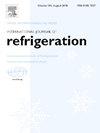Numerical study on effects of wettability on performances of CO2 ejector
IF 3.5
2区 工程技术
Q1 ENGINEERING, MECHANICAL
International Journal of Refrigeration-revue Internationale Du Froid
Pub Date : 2025-01-16
DOI:10.1016/j.ijrefrig.2025.01.015
引用次数: 0
Abstract
Inner wall surface wettability could affect ejector performances, however, no-slip wall boundary conditions were mostly assumed in CO2 ejector simulation studies. In this study, we introduced velocity slip boundary condition into the 3D heterogeneous mixture model for a two-phase CO2 ejector, by using different apparent contact angle at the inner wall of mixing chamber, motive nozzle or diffuser. Numerical simulation results show that the inner wall wettability of mixing chamber and diffuser affects flow and mass transfer in a CO2 ejector significantly, while the inner wall wettability of motive nozzle affects ejector performances very slightly. As apparent contact angle increases from 5° to 175°, resulting in the change of slip condition from negative slip to no-slip then to positive slip, velocity in mixing chamber increases, pressure in mixing chamber decreases, expansion angle after motive nozzle outlet decreases, thus backflow vortices become smaller then disappear. This leads to an increase in suction mass flow rate, and entrainment ratio can be enhanced over 15 %. Correlations between entrainment ratio and apparent contact angle at the wall of different parts in ejector were developed. As the wall wettability changes from hydrophilic to superhydrophobic, the variation trends of ejector performances are similar under different operating conditions with motive nozzle inlet in the supercritical, near-critical, and subcritical regions. This study is helpful to understand flow mechanisms inside the CO2 ejector with different wall wettability, and provides a new approach to improve the performances of a two-phase CO2 ejector by changing wall surface wettability.
求助全文
约1分钟内获得全文
求助全文
来源期刊
CiteScore
7.30
自引率
12.80%
发文量
363
审稿时长
3.7 months
期刊介绍:
The International Journal of Refrigeration is published for the International Institute of Refrigeration (IIR) by Elsevier. It is essential reading for all those wishing to keep abreast of research and industrial news in refrigeration, air conditioning and associated fields. This is particularly important in these times of rapid introduction of alternative refrigerants and the emergence of new technology. The journal has published special issues on alternative refrigerants and novel topics in the field of boiling, condensation, heat pumps, food refrigeration, carbon dioxide, ammonia, hydrocarbons, magnetic refrigeration at room temperature, sorptive cooling, phase change materials and slurries, ejector technology, compressors, and solar cooling.
As well as original research papers the International Journal of Refrigeration also includes review articles, papers presented at IIR conferences, short reports and letters describing preliminary results and experimental details, and letters to the Editor on recent areas of discussion and controversy. Other features include forthcoming events, conference reports and book reviews.
Papers are published in either English or French with the IIR news section in both languages.

 求助内容:
求助内容: 应助结果提醒方式:
应助结果提醒方式:


